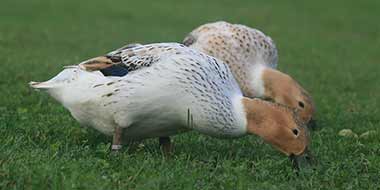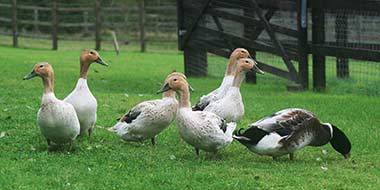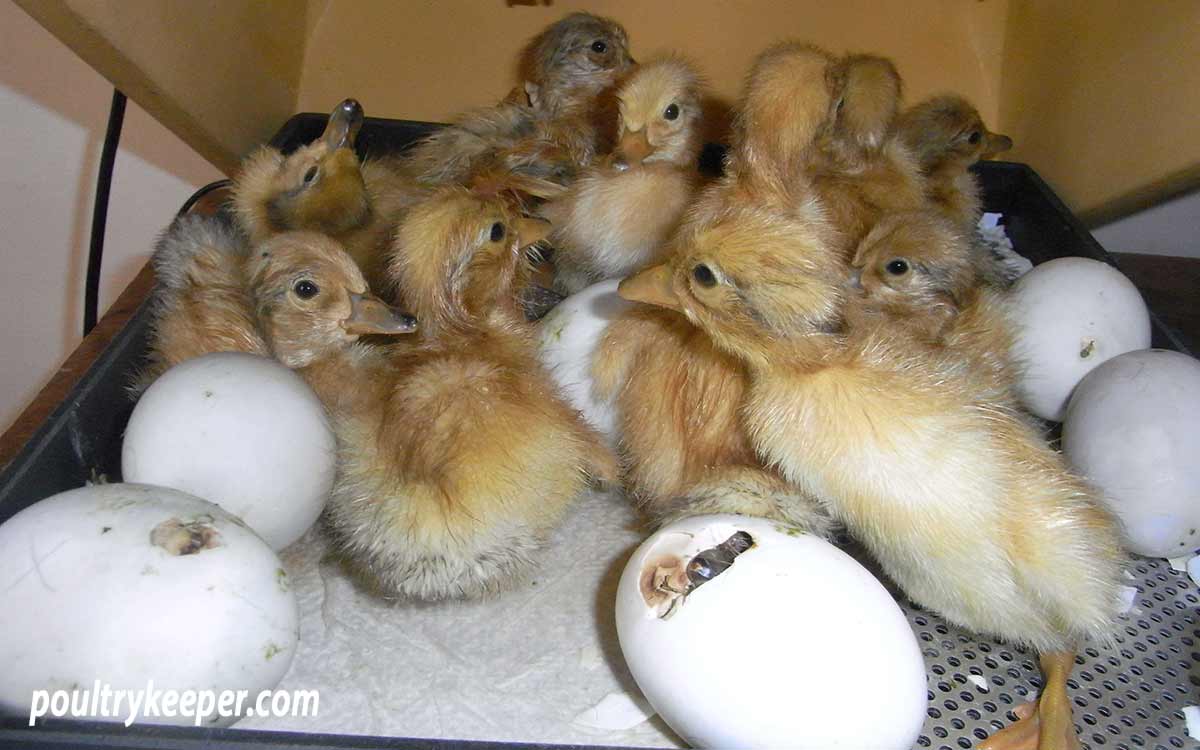
Raising ducklings at home is relatively straightforward. They are more tolerant to disease and with the right equipment, are easier to brood than chicks; however, if we try brooding ducks in the same way, then with their love of water, they can soon make a mess!
In this guide, you will learn all you need to know about preparing a duckling brooder and raising baby ducks.
Ducklings can tolerate less than perfect brooding conditions, although this shouldn’t be an excuse to raise them in sub-standard conditions.
If you have been used to raising chicks, be prepared to make a few changes to your setup because ducklings will inevitably create more mess. Some people tell me they were put off raising ducklings for life after their first attempt!
Ducklings have a habit of dabbling in their feeder and water container for the best part of the day, emptying their water, flicking it about the brooder and soaking the floor. Combined with muck coming out of ‘the other end’, it’s the perfect recipe for a mess.
Ducklings nibble newspaper (which of course soon gets wet), eat wood shavings and can even pop an infra-red heat lamp as they flick water over the hot surface.
It can be challenging providing them with clean conditions in their brooder, but don’t give up just yet. There are some tricks that waterfowl breeders use to overcome these problems.
The duckling brooder
Brooding ducks on a mesh floor
It is a good idea for the first five or six weeks to keep ducklings in a garage, outbuilding or utility room, because of the smell and mess they create.
The best way to avoid wet, dirty floors is to use a rigid wire mesh floor or mesh where their drinker sits, allowing water and muck to fall through, keeping the duckling’s brooder dry.
You can make your own brooder, select a 1cm² galvanised mesh. Allow at least one square foot (30cm²) for every three ducklings.
Construct a box out of wood, attach the mesh to the floor. Another popular option for raising a small number of ducklings is to buy a large plastic storage box and carefully cut out a hole in the middle of the floor.
Cut the mesh to the size of your container. Line the entire box floor with one mesh piece, so the ducklings do not slip on the plastic. Ensure there are no gaps significant enough to get feet trapped.
For the first week, you can use an old towel on the floor of the brooder to provide extra comfort. You can use old newspapers with care: check the ducklings don’t slip, because they can quickly get spraddled legs when young, and take it away before they start dabbling in their water and making it wet because they will eat it!
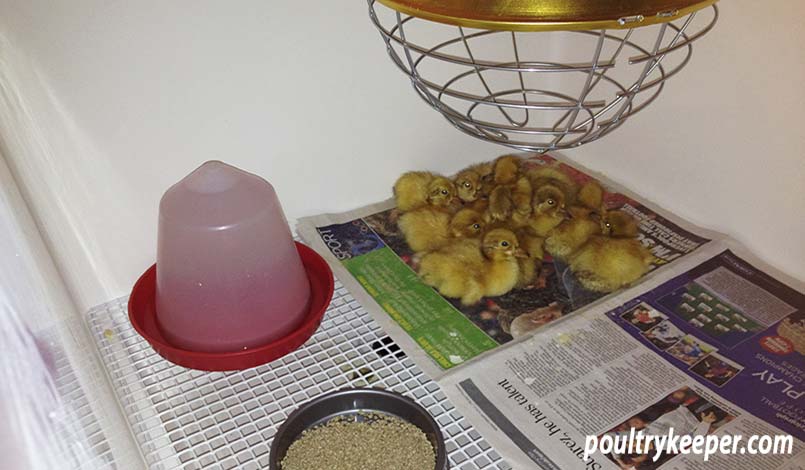
Suppose you can find boxes that stack, you could use a second box underneath with a hole cut out of the lid to catch the waste. It can be emptied and cleaned quickly and protects the ducklings from drafts. The sides needn’t be any taller than 6 inches, so it is worthwhile looking at under bed storage boxes.
Deep litter system
An alternative to a wire floor is to use a deep litter system. Since there will be a lot of water on the brooder floor, at least 3 to 4 inches of absorbent litter is required. As this gets wet, you must change it. As the ducklings get older, placing their water container onto a shallow tray can catch some of the water they spill.
Ducklings will sometimes eat wood shavings, especially during the early days when they haven’t learned where their food is, so use an old towel on top of the shavings for the first week and then keep a close eye on them when you remove the towel.
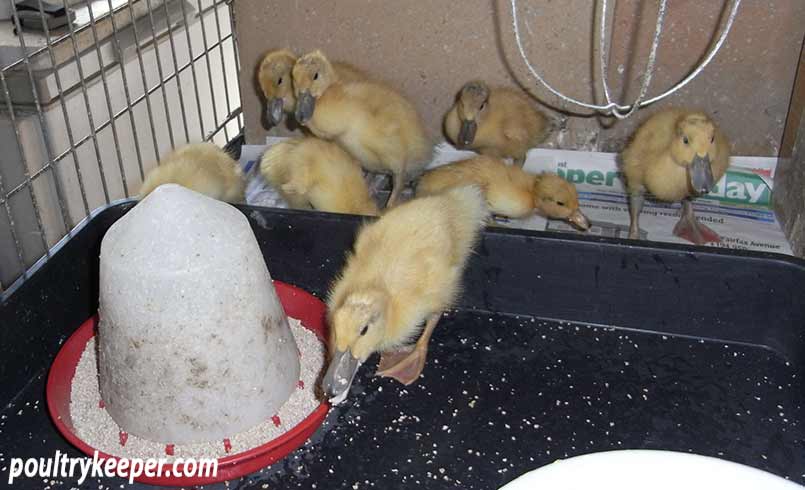
Heating the brooding area
Choice of heatlamp & brooding temperatures
One significant advantage of raising ducklings over chicks is that ducklings don’t require as much heat because ducklings have more fat to keep themselves warm. As well as having a cheaper electricity bill, when you think you can’t possibly cope with their mess any longer, providing the weather is mild, you can transfer them to housing outdoors.
We need to set the correct temperature in the brooder according to their age.
Duckling brooder temperature
The temperature for brooding ducks is lower than for chicks. Take readings on the floor of the brooder, underneath the heat.
- 32°C/90°F during the first week.
- Lower the temperature by 3°C/5°F per week until room temperature when you can turn off the heat.
- Continue to count down 3°C/5°F per week. Move ducklings outside when they can cope with the minimum daytime temperature.
Cold ducklings soon lose their appetites and do not grow well so ensure they have sufficient heat to keep warm.
One of the best ways to provide heat to ducklings is by using a ceramic dull emitter bulb.
These don’t give out any light, so it is better to locate the brooder near a window, but out of direct sunlight, so your ducklings can have a natural day and night.
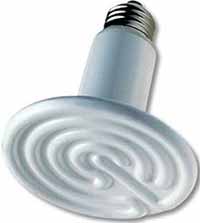
Another solution is to keep ducklings warm using an electric heated brooding panel. These come in various sizes with the Brinsea Ecoglow being one of the most popular for a small number of ducklings.
As with chicks, the ducklings will tell you if they are cold because they will be noisy and huddled together under the heat lamp. When they are too hot, they will stay away from the heat lamp and pant if severely overheated. Ducklings will sleep peacefully under the heat lamp and wander off to eat and drink when they have the proper amount of heat.
It is crucial to ensure you heat only one end of the brooding area so that ducklings can cool off if it’s too warm. It is essential, even at the start of the brooding period. Water containers should be placed at the opposite end to the heat lamp to avoid splashes.
Feed
From day-old to about three-weeks, ducklings should be fed waterfowl crumbs or if these are not available, unmedicated chick crumbs. It is essential to get this right – medicated chick crumbs contain drugs for the prevention of coccidiosis. Ducklings eat more crumb than chicks so will overdose and go off their feet quickly and possibly die.
I use Fancy Feeds Chick Crumbs which are unmedicated but do check ingredients for Coccidiostats/ACS (Anti-Coccidiostats) or other drugs added to any crumbs you buy.
Greens such as grass and dandelion leaves can be cut up and provided in a small dish daily.
Ducklings absorb the yolk sac just before they are born, giving them sufficient energy to hatch and for their first day, so don’t worry if they don’t eat or drink for 24 to 36 hours.

From three weeks, you can start changing their food over to poultry growers pellets. Again, these should be unmedicated.
There is more information about feeding ducklings on this page.
Water
Wet ducklings chill very quickly so as well as providing a brooder with a suitable mesh or deep litter floor; we must provide their drinking water in narrow-lipped containers to prevent them from climbing in and getting wet.
We can provide water for bathing after the first couple of weeks, but you should keep this away from heat lamps, so they don’t get splashed, and you should only put containers down for a short time. Once the ducklings have finished bathing, remove the bath and ensure they dry out under the warmth of the heat lamp and are not shivering.
Bath time
You can provide a shallow tray for baths when raising ducklings indoors. A painting tray is useful because it has a built-in ramp.
It would be best if you supervised bath time. There is a risk of water splashing over the heat lamp, so I raise this and turn it off while they bath. Once they have finished, they will preen their feathers and feel cold, so remove their bath and replace the heat lamp, making sure they can get underneath to dry off.
Another option is to make them a bath outside and take them out on warm, sunny days. Once they have finished, put them back into their heated brooder.
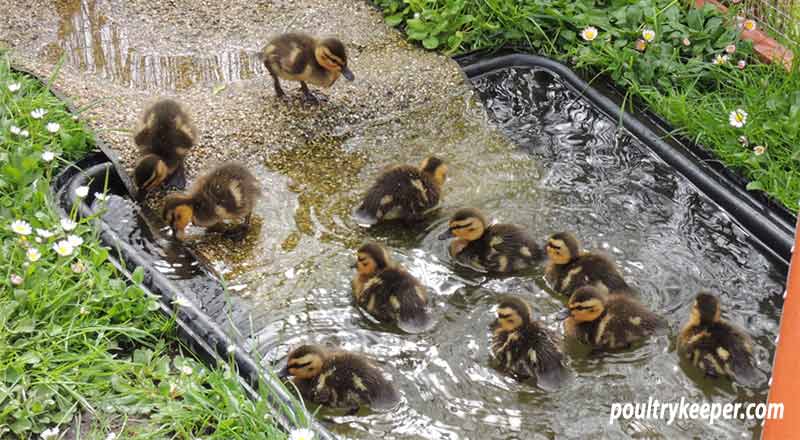
Moving ducklings outside
By about six weeks of age, assuming the weather is mild, ducklings can be moved to a small house and run outside where they will be able to forage for some of their food.
They are still vulnerable to predators at this age, so if there are birds of prey, rats, crows, even magpies, nearby, they will need to be in a secure, covered run.
A movable run is useful for providing them with fresh pasture as they grow.
I have used open runs, but they have been near my house. My family has been in and out through most of the day to keep an eye open.
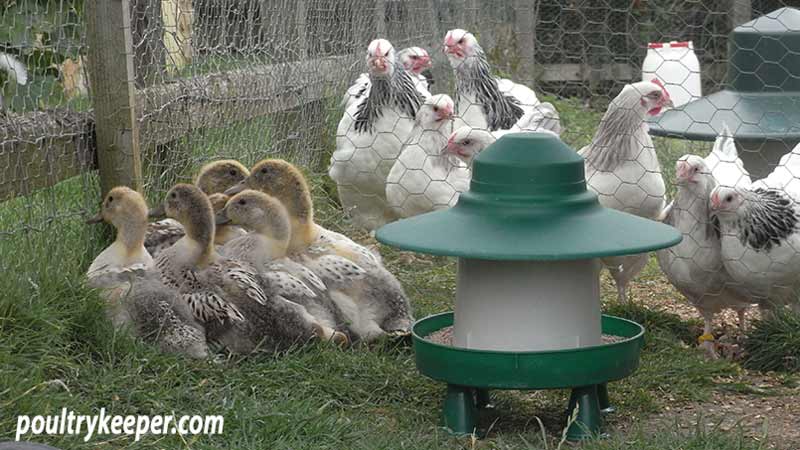
We should cover runs during wet weather, so the ducklings don’t get wet, and their run doesn’t get muddy. In larger runs that cannot be covered, you should keep them in on wet days.
Ducklings are not waterproof. In the wild, the mother duck will use oil from her preen gland, and this will rub off onto her young, but when we raise ducklings without a mother, they can get soaked through and chill quickly.
Do not let them bath outside unless it is a warm, sunny day, or you will need to dry them off under the heat lamp afterwards.
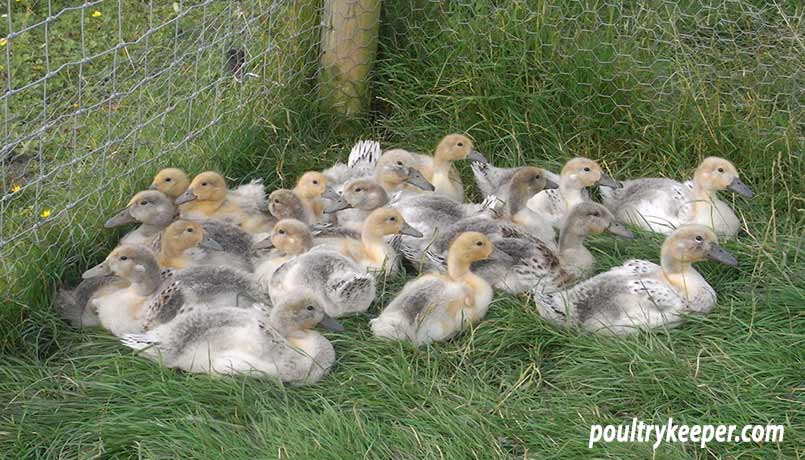
At night your ducklings will need to be put to bed in their house. Unlike chickens, we can round up ducks easily. Once inside, they will huddle together to keep warm.
Related Articles:
You might also find these articles useful:
- Beginners Guide to Keeping Ducks - Everything you need to know about keeping (adult) ducks.
- Keeping Ducks and Geese - My review of one of my favourite books about keeping ducks and geese.
- Feeding Ducklings - Help on feeding ducklings
- Can you keep chickens and ducks together - A very common question!
As your ducklings outgrow their accommodation and become fully feathered, they can be put into more extensive, open runs and kept as you would keep adult ducks.

